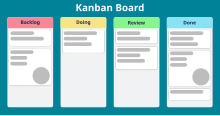
Back كانبان (هندسة برمجيات) Arabic Канбан (разработка на софтуер) Bulgarian Kanban (desenvolupament) Catalan Kanban (Entwicklung) German Kanban (desarrollo) Spanish کانبان (توسعه) Persian Kanban (développement) French Kanban (szoftverfejlesztés) Hungarian かんばん (ソフトウェア開発) Japanese 간반 (소프트웨어 개발) Korean
A major contributor to this article appears to have a close connection with its subject. (August 2022) |

| Part of a series on |
| Software development |
|---|
Kanban (Japanese: 看板, meaning signboard or billboard) is a lean method to manage and improve work across human systems. This approach aims to manage work by balancing demands with available capacity, and by improving the handling of system-level bottlenecks.
Work items are visualized to give participants a view of progress and process, from start to finish—usually via a kanban board. Work is pulled as capacity permits, rather than work being pushed into the process when requested.
In knowledge work and in software development, the aim is to provide a visual process management system which aids decision-making about what, when, and how much to produce. The underlying kanban method originated in lean manufacturing,[1] which was inspired by the Toyota Production System.[2] It has its origin in the late 1940s when the Toyota automotive company implemented a production system called just-in-time, which had the objective of producing according to customer demand and identifying possible material shortages within the production line. But it was a team at Corbis that realized how this method devised by Toyota could become a process applicable to any type of organizational process. Kanban is commonly used in software development in combination with methods and frameworks such as Scrum.[3]
- ^ Womack, James P. (2007). The Machine That Changed the World. Simon & Schuster. ISBN 978-1847370556.
- ^ Ohno, Taiichi (1988). Toyota Production System: Beyond Large-Scale Production. ISBN 978-0915299140.
- ^ Corey, Ladas (2008). Scrumban and other essays on Kanban System for Lean Software development. Seattle, Washington: Modus Cooperandi Press. ISBN 9780578002149. OCLC 654393465.